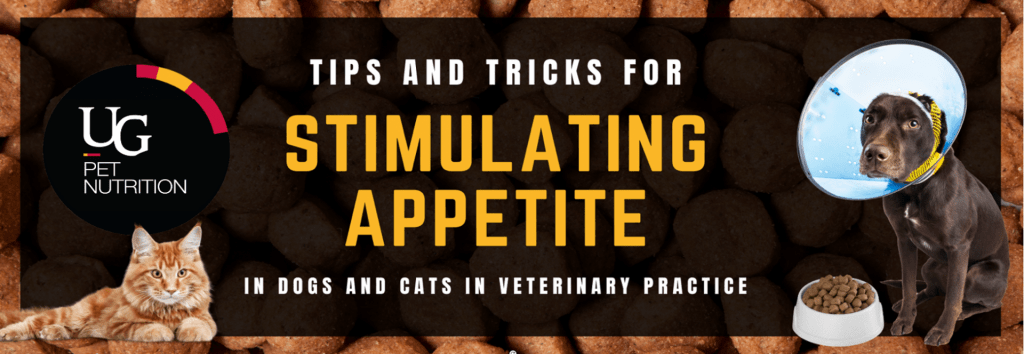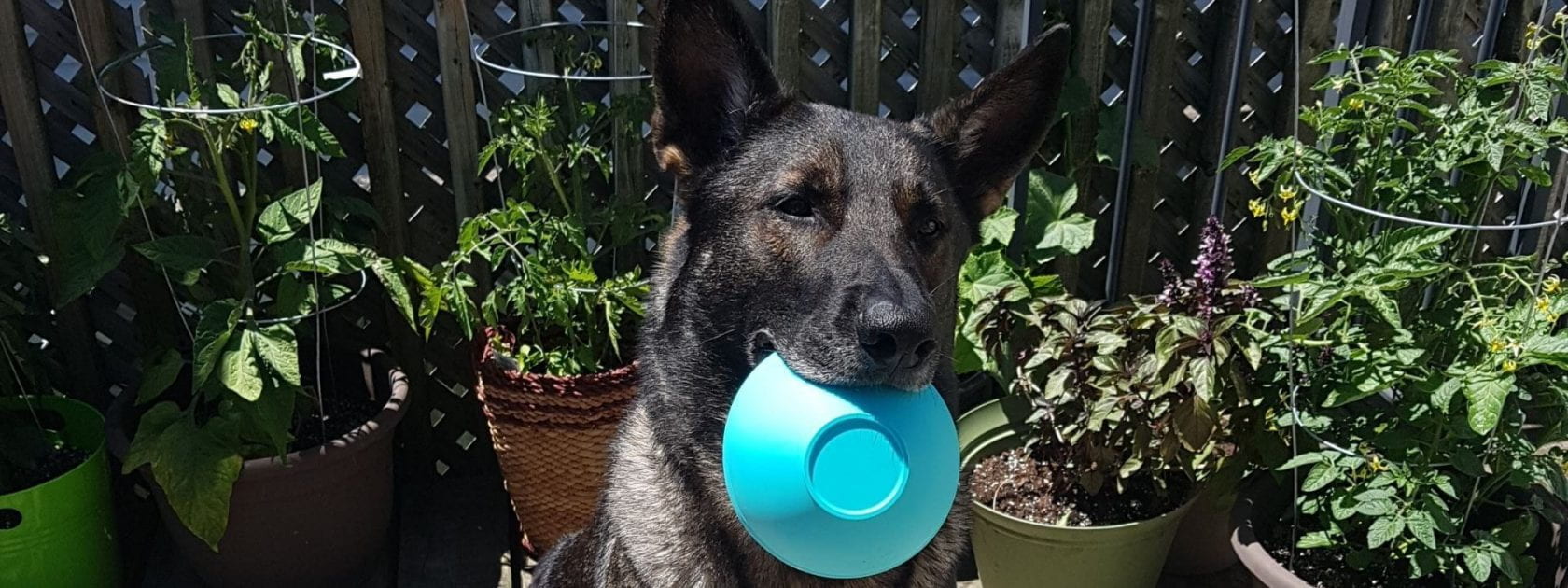
Stimulating Appetite in Dogs and Cats in Veterinary Practice
In veterinary medicine, it is not uncommon to encounter a picky eater in the clinic. Pets can be stressed in the busy clinic environment, and then throw in a surgical procedure or illness into the mix and pets may experience nausea or lose their appetite completely. Even when a patient is willing to eat, they may not be eating enough. Ensuring that the needs of our patients are met nutritionally is vital to a good outcome. If you are a veterinary professional, follow these tips and tricks for stimulating appetite in your patients while they are in hospital.
You may also download the free printable version of our poster and post it in your clinic below:

 What about temperature?
What about temperature?
Sometimes getting a picky pet to eat can be as simple as playing with the temperature. After all, we each have our preferences for how we like our food. Try varying the temperature by warming up your patient’s food. This might enhance the aroma and increase palatability. Be sure to mix after heating and test for hot spots to prevent burns.
 Add something to it!
Add something to it!
When a pet is experiencing pain or anxiety, they may not be interested in eating the food in front of them. A good way to encourage appetite is to top dress the food with a small amount of something “tasty”. Adding cooked beef, rice, pumpkin puree and peanut butter (free of xylitol) are all great additions when in done in small amounts. The key here is to ensure that the patient’s regular food still makes up a majority of the meal.
 Rethink how you are feeding!
Rethink how you are feeding!
Not every patient that visits the animal hospital is a social butterfly. As such, staying in the hospital for an extended period of time can be very stressful for a pet, especially when recovering from illness or surgery. Stress can act as an appetite suppressant and can greatly control how much of their food your patient will consume. Is the clinic overly loud today? Perhaps the kennel neighbour next to your picky eater cat is quite territorial. Ensuring that as many controllable environmental stressors have been removed is key here. If you cannot remove the stressor from your patient’s proximity, try moving your patient somewhere quiet, such as an empty exam room or the staff washroom. For patients that thrive on stimuli, making mealtime fun by using their food as “treats” is a great way to get them engaged and eating.
 Method of feeding and Management!
Method of feeding and Management!
Bowl too big or too small? Try playing with various methods of feeding your patient such as enrichment feeding by placing the food in various mediums or try handfeeding. If they are willing to eat but aren’t eating much, try an energy-dense food (more kcals per cup or can). Energy dense foods are great because the pet does not have to eat as much compared to a lower density food, but they will still meet their caloric, micro and macronutrient requirements.
Another important step to take when you have a reduced appetite patient is to monitor food consumption relative to the patient’s daily Resting Energy Requirements (RER). Just as the name suggests, RER represents the energy requirement needed for a pet to digest and absorb food and maintain body temperature at rest and is based on their body weight. Calculating your patient’s RER and using this as a target for calorie consumption while in the hospital is an excellent goal. Monitoring food consumption closely allows you to quantify how much a patient is actually consuming compared to how much they should be consuming.
To calculate the daily RER for your patient, use the following: RER in kcal/day=70 X (bodyweight in kg)0.75

Finally, evaluating pain score and pain control is very important. Has their pain following surgery increased? Perhaps the current medications that your patient is on is influencing their appetite.
 Texture! Texture! Texture!
Texture! Texture! Texture!
The texture of your patient’s food can have a large impact on their willingness to eat. Before top dressing their food with a tasty food item as mentioned in the “Add” section, consider trying a different food texture such as dry, canned, stew or loafed. Speak with the pet owner and ask them what texture of food the pet typically prefers at home. If your patient is a cat that only ever eats dry food at home, he or she may not recognize the canned food you are trying to feed them in the clinic. Dry kibble can sometimes be too dry and simply adding some water to the mix can made a big difference. Additionally, you can experiment with stewing the food by mixing both dry and wet food together. The addition of varying amounts of water to change a food’s consistency is also a great way to increase hydration in patients.
 How long have they not been eating?
How long have they not been eating?
When trying to get your patient to eat, you will want to avoid anything that will further decrease appetite. It is critical to not leave unconsumed food beyond 25 minutes with your patient. This can increase nausea, cause further discomfort, and even lead to a food aversion. Take a break and try again in a few hours. Sometimes no matter what you try, some patients will just not eat. This is where knowing your patient’s RER is very important. Each veterinary case is unique and should be treated as so. If your patient is consuming less than half of their RER for more than 3 days, further intervention such as assisted enteral feeding may be needed. Additionally, an appetite stimulant may also be beneficial here. Consultation from a board-certified veterinary nutritionist is recommended.
When reintroducing full caloric intake, be mindful of refeeding syndrome as a potential, life-threatening complication. It may occur when complete anorexia has been present for 3 or more days, or hyporexia for beyond 5 days. To minimize risk, caloric intake should be increased gradually over 3-4 days, while monitoring electrolytes and for potential symptoms. The patient with refeeding syndrome may demonstrate cardiovascular or neurological abnormalities, along with behavioral changes, peripheral edema and non-regenerative anemia.
If you are a pet parent, a complete lack of appetite should be considered a serious symptom. Any changes in your pet’s appetite should be shared with your veterinary team as this may indicate an underlying concern.
Written by:
T. Connor McCorkell
Clinical Nutrition Research Intern |Department of Clinical Studies, Ontario Veterinary College
Edited by:
Dr. Caitlin Grant, BSc, DVM, DVSc.
Assistant Professor, Nestle Purina Professorship in Companion Animal Nutrition
Shoshana Verton-Shaw, RVT, VTS (Nutrition)
Registered Veterinary Technician in Nutrition
Supported by Purina® Pro Plan® Veterinary Diets
Dr. Adronie Verbrugghe, DVM, PhD, EBVS® Specialist in Veterinary and Comparative Nutrition (Dip. ECVCN), Associate Professor, Royal Canin Veterinary Diets Endowed Chair in Canine and Feline Clinical Nutrition
Department of Clinical Studies, Ontario Veterinary College
Disclaimer
The information provided in this blog post is for educational and informational purposes only and is not meant as a substitute for professional advice from a veterinarian. Any access to this information is voluntary and at the sole risk of the user. If you have or suspect that your pet has a medical problem or condition, please contact a qualified
veterinary health care professional immediately.


